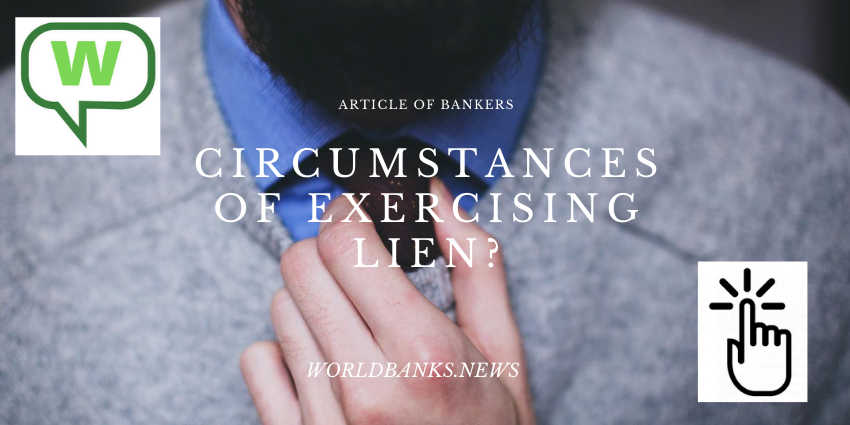CIRCUMSTANCES OF EXERCISING LIEN ?
EXERCISING LIEN :-
If the following conditions are fulfilled, a banker can exercise his right of lien.
1) There must not be any agreement in consistent with the right of lien.
2) The property must come into the hands of a banker in his capacity as a banker.
3) The possession should be lawfully obtained in his capacity as a banker.
4) The property should not be entrusted to the banker for a specific purpose. Banker‘s Lien As An Implied Pledge :-
A banker‘s lien is generally described as an implied pledge. It means that a lien not only gives a right to retain the goods but also gives a right to sell the securities and goods of the customers after giving a reasonable notice to him, when the customer does not take any steps to clear his arrears. This right of sale is normally available only in the case of pledge. That is why lien is regarded as an implied pledge. This right o sale is available only is exceptional circumstances in the case of lien. Right of appropriation [Clayton‘s Rule]
This is the right of a banker to appropriate the money paid by the customer to any one of the loan including a time barred debt. The customer has more tan once account on has taken more than one loan from the banker. At the time, the question of appropriation of the money subsequently deposited by him are arises, section 59 to 61 of the Indian contract Act, 1872 contain provisions regarding the right of appropriation of payment in such cases. According to the right of appropriation.
1. When payments are made by debtor to the creditor the debtor has a right to inform the creditor as toward which loan he is making payment [section 59].
2. When the debtor has not exercised his right, the creditor ha the right to appropriate the payment made by debtor towards any loan according to the discretion of the creditor [section 60].
3. When neither debtor or creditor exercises their right for appropriation, then it is the chronological order in which the debit entries have arises in the same sequence the credit entries will go to discharge the debit entries [section 61]
4. In case of debt due with interest, any payment made by the debtor in the first instant is to be applied towards satisfaction of interest and agreement to the contrary.
The relevance of apocopation arises in the case of death, insolvency or retirement of a partner of a firm. Here, the banker will close the old account and open a new account in the name of rosining partners. This enables the banker to decide the liability of the deceased, retired an insolvent partners. The loan can be recovered even from the estates of the deceased partner.
C.layton‘s care :-
A firm of bankers known as Reuagners, Dalies, Noble by co had five partners. Devaijnes, the senior partner, died and the spurning partners carried on the business of banking under the same name After a year the firm because bankrupt and various clarred of creditors of the firm placed their claims against the estate of revenges the deceased partner .
N. Clayton was one of those creditors who continued to deal with the surviving partners by making payments to and receiving payment from the bank. At the time of death of revenges, clayton‘s balances was 1,713. During the net few days he with drew several times and thus the balance was reduced to & 453. Thereafter surviving partner paid more than & ,1713 to him and subsequently his deposits with the firm largely exceeded the amounts with drawn by him and thus his credit balance at the time of bankruptcy of the firm was larger then the amount which was due to him at the time of deposable of deafness, clayton claimed that the amount of Z 45‘s was due to him from the estate of the deceased partner, It is contention was that.
i) The withdrawals from the amount after the death of the partner were paid out of the deposits made in the same period, and
ii) The credit balance standing at the time of the partners death was reconcilable from the deceased partner‘s assents. There arguments were not accepted by the court and clayton‘s claim was rejected.
RIGHT OF SET OFF:-
The mutual claims of debtor and creditor are adjusted together and only the reminder amount is payable this right off set off which enables him to combine two accounts in the name of the same customer and to adjust the debit balance in one account with the credit balance in the other. For example :-
A banker has allowed on overdraft to Mr.x. amounting to Rs. 25000 and Mr. x ‗s savings Bank account shows a credit balance of Rs. 10,000. In case x fails to pay the overdraft, the banker can execs his right of et off by combining both account‘s by which the banker can claim the net difference of Rs. 15,000 from his customer. The mutual adjustment of debit and credit balances is called set off. The right of set-off can be exercised subject to the fulfillment of the following conditions :-
1) The capacity of the parties both in the debit and credit accounts should be one and the same i.e., the same customer should have the deposit account and loan account.
2) The loan must he outstanding and over due where a loan amount is not over due, right of set off cannot he expertise.
3) The right can be exercised in respect of debts due and not in respect of future debts.
4) There should not be any agreement controls to due right of set off. A banker has the automatic right of let of in the following cases.
i) On the death in slovenly and inanity of the customer.
ii) On receiving a notice of assignment of a customer‘s credit balance.
iii) On insolvency of a firm on winding up of a company.
iv) On the receipt of a garnishee order from the court.
v) On the receipt of notice of second charge over securities montage. Garnishee order
The banker‘s obligation to honour a customer‘s cheques is extinguished on receipt of a court odder know as the Garnishee order, issued under order 21, Rule 46 of the ill procedure code, 1908. If a debtor fails to pay the debt owed by him to his creditor, the creditor may apply to the court for the issue of a Garnishee order on the banker of his debtor. Such order attaches the debts not secured by negotiable instrument, by prohibiting the customer from receiving the debt ad the debtor from making payment thereof. The amount of the customer with the banker, thus becomes suspended and the banker is under an obligation not to make any payment from the account concerned after the receipt of the Garnishee order.
The creditor at whose request the order issued is called judgment – creditor the debtor whose money is forzen is called Judgment debtor and the banker who is the debtor of the Judgment debtor is called the Garnishee. This order issued in two parts :
a) The court directs the banker to stop payment out of the account of the Judgment debtor. It is an order called ‗order wise‘ also seeks explanation from the banker as to why the funds in the Sid account should not be utilized for meeting the Judgment creditor‘s claim. The banker is prohibited from paying the amount due to his customers on the date of receipt of the order ill.
b) After the banker files his explanation, if any the court issues the final order called order absolute‘ whereby the funds in the account are attached to be attached to be handed over to the judgment creditor. The judgment account may be received after payment has been made to the judgment creditor as per the directions of the court. Effects of Garnishee order :- When Garnishee order is issued, the following will be the effect on the banker.
i) The banker has to suspend operation of the account of the Judgment debtor.
ii) The cheques drawn by the judgment debtor on the garnishee account should not be honoured after the order is issued on the bank.
iii) When the order is made absolute the balance available should be made over to the Judgment creditor as per the direction of the count. If the customers balances is not sufficient to over the dues, then the banker has to pay whatever is available on the judgment debtor‘s account.
iii) The suspended account of the judgment debtor may be received after payment has been made to the judgment creditor as per the direction of the court.
Rights And Duties Of A Banker :-
i) Banker‘s lien.
ii) Bankers right of set off.
iii) Bankers right of appropriation
iv) Law of limitation.
v) Banker‘s Right to charge compound internet.
vi) Banker‘s Right of incidental expenses.
Iii) Law O Limitation :-
Under Actual 22 of part of the schedule to the limitation Act, 1963 the period of limitation for the refund of bank deposits in three years with effect from the date a customer makes a demand for his money. A debt a customer makes a demand for his money. A debt a customer makes a demand for his money. A debt becomes time – barred if it is not repaid with in three years after it is contracted. The three years conditions is not considered when the date of money deposited in bank without any transitions having taken place, the debt due by the bank will not be time barred.
Iv) Banker’s Right To Charge Compound Indirect :- A banker grants loan and advances to customers and charges internet on the same. bankers usually debit the customers account when a customer ails to pay the interest amount every month. Afro period of thee months, the interest will be added on the principal amount and the principal amount inflated Internet will now he charged on the new principal amount. This kind of Interest added will the principal is called compound internet and the banker has every right to do so.
Ii) Banker’s Right To Claim Incidental Charges :- As long as the relation of a banker and customers exists, the banker has an implied right to claim commission, interest and other incidental charges for the services rendered to the customers. They are not payable in cash but are debited in the accounted as and when they become due. If a customer is unable to keep a gemunezatiue credit balance, the banker in India charges Rs.10 to Rs 50 per half year.




















